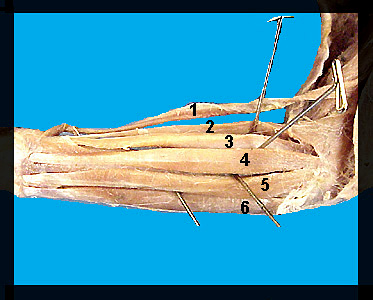|
|
|
|
||||||||||||||||||||||||||||||||||||||||||||||||||||||||||||||||
|
Compared to the upper arm, the forearm has more complex functions to perform such as supination and pronation of the paw (manus), extension and flexion of the paw, wrist and digits. Consequently, the muscles of the forearm are not so large as those of the upper arm but they will be more numerous and complex given their multiple functions. The brachioradialis is a long, narrow band-like muscle that passes along the medial border of the forearm. Its originates on the humerus and inserts on the radius. The extensor carpi radialis longus and extensor carpi radialis brevis are located beneath the brachioradialis. Their origin is the lateral surface of the humerus above the lateral epicondyle and their insertion is on the metacarpals. Note that the extensor carpi radialis brevis is the shorter of the two. The action of these two muscles is to extend the manus (paw). The next muscle encountered as you progress laterally is the extensor digitorum communis. This muscle originates from the lateral surface of the humerus above the lateral epicondyle. At its insertion, it divides into four tendons that insert onto the phalanges of digits two through five. The action, as its name implies, is extension of the second, third, fourth, and fifth digits. Just lateral to the extensor digitorum communis is the extensor digitorum lateralis. This muscle also has its origin on the lateral surface of the humerus above the lateral epicondyle. Its tendon subdivides three to four times depending on the specimen to insert on the digits. Accordingly, its action is to extend the digits. The most lateral muscle (on the ulna side) on the dorsal surface of the forearm is the extensor carpi ulnaris. It originates from the lateral epicondyle of the humerus and inserts on the lateral aspect of the fifth metacarpal. This muscle produces extension of the paw at the wrist (carpals) on the ulna side. |
|
